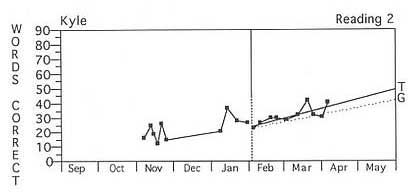Introduction
Curriculum-Based Measurement (CBM) is a method teachers use to find out how students are progressing in basic academic areas such as math, reading, writing, and spelling. CBM can be helpful to parents because it provides current, week-by-week information on the progress their children are making. When a child’s teacher uses CBM, he or she finds out how well the child is progressing in learning the content for the academic year. CBM also monitors the success of the instruction a child is receiving – if a child’s performance is not meeting expectations, the teacher then changes the way of teaching the child to try to find the type and amount of instruction the child needs to make sufficient progress toward meeting the academic goals. This issue of NASET’s Assessment in Special Education series will focus on the importance of Curriculum-Based Measurement. It was written by Kathleen McLane and developed through Cooperative Agreement (#H326W0003) between the American Institutes for Research and the U.S. Department of Education, Office of Special Education Programs.
What is CBM?
Curriculum-Based Measurement (CBM) is a method teachers use to find out how students are progressing in basic academic areas such as math, reading, writing, and spelling. CBM can be helpful to parents because it provides current, week-by-week information on the progress their children are making. When a child’s teacher uses CBM, he or she finds out how well the child is progressing in learning the content for the academic year. CBM also monitors the success of the instruction a child is receiving – if a child’s performance is not meeting expectations, the teacher then changes the way of teaching the child to try to find the type and amount of instruction the child needs to make sufficient progress toward meeting the academic goals.
How Does CBM Work?
When CBM is used, each child is tested briefly each week. The tests generally last from 1 to 5 minutes. The teacher counts the number of correct and incorrect responses made in the time allotted to find the child’s score. For example, in reading, the child may be asked to read aloud for one minute. Each child’s scores are recorded on a graph and compared to the expected performance on the content for that year. The graph allows the teacher and parent to see quickly how the child’s performance compares to expectations. (The figure at the end of this article is an example of what a CBM graph looks like.)
After the scores are entered on the graphs, the teacher decides whether to continue instruction in the same way, or to change it. A change is called for if the child’s rate of learning progress is lower than is needed to meet the goal for the year.
The teacher can change instruction in any of several ways. For example, he or she might increase instructional time, change a teaching technique or way of presenting the material, or change a grouping arrangement (for example, individual instruction instead of small-group instruction). After the change, the parent and the teacher can see from the weekly scores on the graph whether the change is helping the child. If it is not, then the teacher can try another change in instruction, and its success will be tracked through the weekly measurements.
Other Ways CBM Can Help You
CBM can also help parents work more effectively with the school system on their child’s behalf. CBM graphs make the goals, and the child’s progress, clear to parents and to the teacher. In this way, CBM can help parents and teachers communicate more constructively. Parents can use the CBM graph in conferences with teachers and administrators, as it gives them specific information about their child’s progress and the success of the instructional methods being used. Parents can also use the CBM graph in IEP (Individualized Educational Program) meetings to go over specific information about their child’s current performance so that they and the school can develop measurable goals and objectives that will lead to more meaningful progress for their child.
For More Information
If you are interested in more detailed and technical information about using CBM. entitled Monitoring Student Progress in Individualized Educational Programs Using Curriculum-Based Measurement, by Pamela M. Stecker.
Sample of CBM Graph

Download a PDF Version of this Issue
To download a PDF file version of this issue of Assessment in Special Education Series – CLICK HERE

